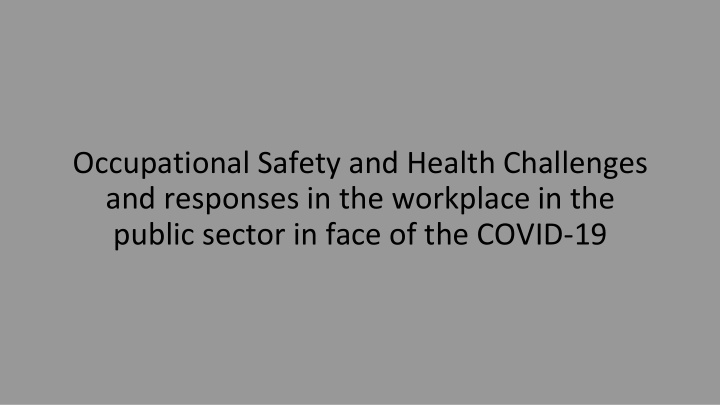



Occupational Safety and Health Challenges and responses in the workplace in the public sector in face of the COVID-19
Opening Statement The COVID 19 pandemic presents a set of unprecedented challenges in all spheres likewise within the Public service. It painted a unique but vivid picture of how basic occupational safety and health safeguards have been compromised within the public service. The pandemic brought into focus the lack of adequate policy guidelines to mandate safer hygienic practices, adherence to protocols, proper administering of Personal Protective Equipment and implementation of more proactive mechanism to better function and operate within public service.
Overall Challenges 1. Coping with uncertainty 2. Psychological Effect (Dimension) 3. Future Prospects
COPING WITH UNCERTAINTY 1. Inconsistent measures applied across various departments in the absence of a clear policy position (e.g application of sick leave, vacation leave, working hours) 2. Insufficient information from official sources left workers uncertain about how to cope (e.g application of sick leave) 3. Delays in installing protective screens 4. Unavailability of PPE and other supplies 5. Slow responses by management to organise business continuity plans and to communicate with workers 6. Adjusting, working and communicating remotely through the use of technology
Psychological Effects • Increased levels of stress; affect ability to remain focus on the job • Panic among workers • Panic buying and fears of food shortages; (concern immediate family needs) • Concerns for caring of family members including children and elderly (priority is family and not work)
Future Prospects • Fear of job loss or reduction of income ( salary cuts) • Fear of getting infected and losing friends and co-workers • Uncertainty about the duration of the crisis (inability to plan) • Fear of the changing nature of work and its impacts in the future
Public Sector Example: Inland Revenue Department T he Inland Revenue Department (IRD) has approximately 165 staff at 5 locations with the majority of staff located within the city capital Castries. The main functions of the IRD are the assessment and collection of taxes. The IRD being cognizant of staff concerns amidst the COVID-19 pandemic, worked to ensure that the necessary actions and policies were implemented for the protection of staff, their safety and well-being in the work place and to manage the threat of COVID-19.
Responses to the threat of COVID-19 1. Increased the frequency of cleaning and disinfecting at all its locations, with particularly emphasis being was placed on the customer service areas; Placement of automatic hand sanitizer dispensers near the restrooms and at all entrances 1. of the various locations, to be used by Taxpayers entering the building; 1. The issuance of hand sanitizers and aerosol sprays to the different Sections/Units throughout the IRD;
1. Development of business continuity plans to identify critical staff for the purposes of ensuring that services continue, albeit with a streamlined staff complement; 1. Provision of periodic updates to staff, when new information became available; 1. Development of protocols/guidelines to inform the interaction of staff with each other and the general public, as well as how services would continue during the outbreak of COVID-19.
S taff were advised to observe the well-established hygienic practices advocated by the Ministry of Health as outlined below: 1. Wash hands with soap and water regularly (rubbing for at least 20 seconds). Use alcohol based (70% and above) hand sanitizer in between washing; 2. Cover a cough or sneeze with a tissue which has to be immediately disposed of; 3. Avoid touching mouth, eyes, nose (avoiding touching M.E.N.); 4. Practice social distancing using a 6 feet perimeter from all persons;
5. Perform alcohol hand rub (using preparations of 70% alcohol based sanitizer) after touching things such as money, elevator buttons, door handles and parking tickets. Staff were strongly encouraged to limit visits to public spaces 6. 7. It is also advised that WHO or PAHO websites should be viewed for additional information.
F ollowing the closure of all non essential services, the following was utilized to ensure continuity of operations and service to the public: 1. Staff rotation schedules with limited opening hours 8am to 12.30pm and limited staff; 2. Staff working from the office were provided with mask and social distancing protocols were observed; 3. Work from home arrangements considered non-essential employees, persons with pre- existing conditions and staff with transportation challenges All staff were notified accordingly of the prepared schedules and the Alternative Work Arrangement Policy developed by the Department of the Public Service was adopted.
Challenges and responses in workplace Challenges Responses 1. Reactive mechanism 1. Communication 2. New policies 2. Inconsistency across Department 3. Creative measures 3. Lack of Business Continuity Plans 4. Revert to traditional practices 4. Unfair administering policy 5. Renewed spirit of collaboration/Teamwork decisions 6. Alternative work arrangement policy
Thank You
Recommend
More recommend